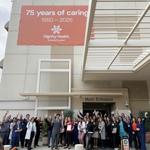Three front-runners have emerged in the race for the Peninsula’s Assembly District 21, the new district spanning from South San Francisco to East Palo Alto.
The open seat comes after Assemblymember Kevin Mullin, D-South San Francisco, announced he would not seek reelection amid his bid for Congress. Mullin since 2012 has represented the outgoing 22nd District, which covers much of the same territory the 21st District now includes as a result of the decennial redistricting process.
The Daily Journal spoke with top candidates Redwood City Mayor Giselle Hale, San Mateo Deputy Mayor Diane Papan and South San Francisco Councilmember James Coleman to find out how they would tackle some of the district’s most pressing issues.
Housing costs have increased exponentially on the Peninsula over the last decade. Heated debates have arisen as some have embraced residential growth to keep pace with job production while others have sought to preserve lower-density areas. The role of subsidized affordable housing is a key part of the discussion.
Papan said funding subsidized affordable housing would be among her top priorities. She said she would use budget surplus money in addition to seeking long-term sources.
“We have a housing shortage, we’re going to have to make it so that more housing is built, whether that’s affordable or even market-rate,” she said. She added that the state may need to provide assistance with new infrastructure to support growth, particularly given state mandates to build housing, which she has been critical of.
Hale, who throughout her time on the Redwood City Council has established herself as a staunch advocate for building more housing, said a priority should be streamlining the complex process of funding below-market rate housing in addition to overhauling the state’s environmental review process that can delay or block projects. She too said building market-rate housing is part of the solution to affordability.
“We need to be collaborating at all levels of government on solutions to solve our housing shortage, and I think the state has a number of roles to play,” she said.
Coleman’s primary housing push has been for state-owned and operated social housing. He said the state should establish self-sustaining developments with affordable rents for low-income residents subsidized by higher rents within the building.
“We need to make sure that we are building a swath of housing, especially at the extremely-low income levels,” he said.
Hale is the only candidate of the three to have supported the state’s controversial Senate Bill 9, which allows duplexes in single-family neighborhoods.
While rates of homelessness in the district have climbed in recent years, they remain relatively low compared to surrounding areas. The most recent count showed 900 people unhoused and another 600 in shelters in San Mateo County.
Hale said there are four primary causes for homelessness: not enough housing, housing that is available costs too much, unaddressed physical or mental illness and domestic abuse. She pointed to her work in Redwood City to establish a safe parking program for people living in their vehicles as a step in the right direction.
Papan also said housing costs and mental health are driving factors. As an example of a program she said works, she pointed to the county’s Project Homekey, which provides permanent support housing often in converted hotels.
“You’ve got to have the shelter and you’ve got to have voluntary mental health,” she said.
In addition to addressing housing affordability and bolstering renter protections, Coleman said increasing resources to combat substance abuse like sobering centers was key to combat root causes. He said the state should also expand Project Roomkey, a program started during the pandemic that provides non-congregate shelter to people previously experiencing homelessness. He said transitional work training programs should also be prioritized.
California’s per-capita health care spending ranks among the most expensive in the world, despite persistent gaps in coverage. Democrats are often split on the issue with some looking for sweeping overhauls and other favoring incremental changes. A bill to advance a government-funded universal health care system failed to reach a vote in the Assembly earlier this year.
Coleman, a proponent of a single-payer system, said he would support modest tax increases to extend coverage to every Californian.
“Our system is as inefficient as it is immoral. We can take out the unnecessary for-profit health insurance middlemen and institute a single-payer health care system,” he said. “People would see a modest increase in taxes but they would see a decrease in their spending.”
Hale said the focus should be on improving efficiency of the current system.
“I believe [Medi-Cal] is a system we should continue to invest in, and we should be making it more efficient for both the providers and for the patients,” Hale said.
She added affordable housing for care providers and expanded educational opportunities for people entering the field was also important, and made a case for bolstering access to linguistically and culturally appropriate care.
“That is very important in the care being received and being relevant to that community, so the more that we can do to get folks from all communities in California into these professions, I think is going to make for a healthier community,” she said.
Papan agreed housing and education opportunities for care providers was part of the equation. She said she would work to close the gap in Medicare coverage that excludes people between 25 and 51 years old, and increase funding for mental health.
“Everybody deserves equal access to health care and I see us at least closing that gap,” she said.
Environmental protections and adaptations in the face of worsening climate change is something all three candidates identified as a top priority. Part of the push regionally has been around transitioning buildings away from natural gas use, which the county estimates account for 32% of its greenhouse gas emissions. But converting existing buildings, including single-family homes, has been a touchy subject, with cost and reliability concerns at the forefront.
“We have to boldly move in these directions but not in a way that leaves people without hot water or the ability to cook for weeks,” said Hale.
Citing an increased cost of electric appliances, she said she was not yet ready to institute a burnout ordinance — a rule that would require people to replace gas items like stoves or water heaters with electric alternatives at the end of their life.
Papan shared a similar view, while Coleman said he would support a burnout ordinance, with support from rebates and other financial assistance programs.
“Climate change is something very dear to me, as it’s going to be my generation that’s going to be bearing the brunt of climate change,” he said, adding he would add a tax on oil extraction.
Papan said a key focus should be on carbon extraction. To better dispense renewable energy and improve electric power renewability, she said improving power storage capability and creating micro grids, small power-supply networks separate from the broader Pacific Gas and Electric grid, should be a priority.
Hale said building housing near transit and jobs would be a big part of her environmental focus. She said supporting environmental innovation — like improved solar panels, was also important.
California’s public education funding is notoriously complex, with two separate systems that are either funded largely through property taxes or by the state with additional categorical funding for special programs or targeted assistance. Proposition 13, passed in 1978, prevents property tax rates from increasing as property values rise. A ballot initiative in 2020 sought to reassess tax rates on commercial property worth more than $3 million to present value — a move that would have increased education funding by several billion. The initiative failed by a narrow margin.
Hale and Coleman both said they supported the 2020 measure while Papan said she did not.
“I think the attempt didn’t necessarily come at the right time, during COVID,” said Papan. “Also, the low threshold of $3 million was going to include a lot of small mom-and-pop commercial property owners.”
Hale said she would build on the initiatives and aim to find a compromise that would gain voter approval. Coleman said Proposition 13 reform would be part of a broader suite of progressive taxes he would support.
All three candidates agreed public school funding should be based on enrollment, not attendance as it currently is. Districts with more low-income students, English learners and foster youth students are generally believed to receive less funding as a result of the current formula.
“Until we look at some sort of larger-scale reform, we won’t be able to see the gains on issues like education,” said Hale. “I do believe Prop. 13 furthers [inequities in the state] and I do believe the right place to focus is on large corporations who we are effectively subsidizing.”
Hale said underfunding has also left gaps in the state’s ability to identify and adequately serve students with learning differences or special needs.
Also running is former candidate for Redwood City Council Tania Solé, who is running as a Green Party candidate. Solé, who answered questions by email, said the Legislature needs to strengthen local zoning codes and address the impact of short-term rentals on housing supply, particularly as it pertains to increased density on former single-family home lots. She said homelessness is driven primarily by housing affordability, and substance abuse is a factor that often comes after losing housing. Increasing minimum wage and strengthening residential zoning she said would help address affordability.
On health care, she said the system “needs to be disrupted,” including requirements to “show results in direct correlation to payments.” She added that she was shocked a universal health care bill was not signed during the pandemic.
She said she is concerned about centralizing the state’s energy on a single grid, and advocated for diversifying renewable sources including wave, solar and wind power. She said energy used for transporting water could be saved by investing in local desalination.
For education funding, she said the state needs to move to “equal average per-pupil funding and expenditures” across every district. Pre-kindergarten and infant care, she said, should be part of the equation.
San Mateo County Community College District Board Trustee Maurice Goodman, Republican small business owner Mark Gilham and attorney Alison Madden are also in the running. Voters will get a chance to pick their favorite candidate during the June 7 primary, which will narrow the field to two ahead of November’s general election.




































(1) comment
Congratulations to San Mateo's Deputy Mayor Diane Papan on receiving the endorsement of the important San Mateo Daily Journal.
Diane was one of only two City Councilmembers to vote against the expedited implementation of the poorly-planned and publicized bicycle lanes - which will eliminate 217 street parking spaces in our North Central San Mateo neighborhood.
Welcome to the discussion.
Log In
Keep the discussion civilized. Absolutely NO personal attacks or insults directed toward writers, nor others who make comments.
Keep it clean. Please avoid obscene, vulgar, lewd, racist or sexually-oriented language.
Don't threaten. Threats of harming another person will not be tolerated.
Be truthful. Don't knowingly lie about anyone or anything.
Be proactive. Use the 'Report' link on each comment to let us know of abusive posts.
PLEASE TURN OFF YOUR CAPS LOCK.
Anyone violating these rules will be issued a warning. After the warning, comment privileges can be revoked.